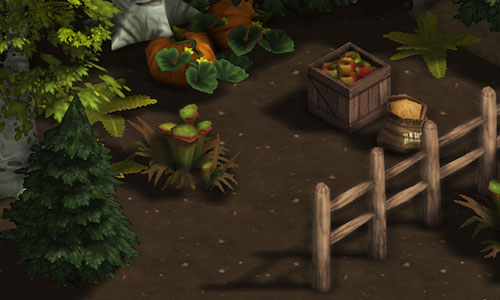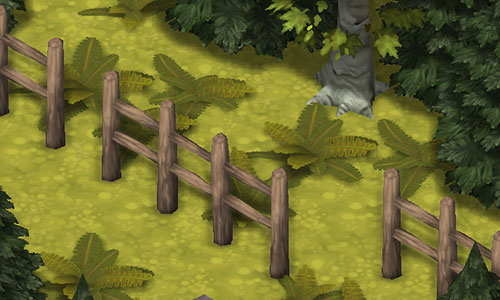It’s amazing how far you can go writing a video game without actually answering really important questions like “how does the game terrain actually work?” In a perfect world, if everything worked as you imagined it would the first time, making video games (on our time scale at least) involves spending a few months building the idea of the game in your head, then spending a year or so whittling each piece out of little wooden blocks and pressing them gently into the computer. This has the added advantage of explaining why our computers are filled with little wooden blocks.
We’re writing the biome code now (well, another iteration of it) which determines what natural objects exist in what areas, be they desert, tundra, jungle, forest, or maybe something weird like an Healthfully Irradiated crater or a la(r)va field, who knows.
There’s a bit of a process to defining how these things exist, what they get to talk to, and how complicated we want to make them: We hammer out a 3 page document on our internal wiki, argue over it (possibly in THE PIT), make Perfectly Necessary Amputations in some places, and more complexity in others, then start actually writing code. Invariably we’ll forget something or make a Horrible Mistake that causes the world to be impaled with giant spikes of rock that are infinitely tall (it happens) and have to rewrite, but that’s the Creative Process.
Every game tile is currently given a temperature & humidity value, a wateriness descriptor (aquatic, wetland, or land), and an integer value for soil quality. We started with a simple 3×3 matrix of temperature and humidity numbers to map biomes on, but it turned we really wanted swamps because they’re 1. creepy and 2. you need somewhere quiet to throw that body or that artifact which Was Never Meant To Be Found. Similarly, we’d like rich, rolling prairies to cleanse of wild aurochs herds and fill with factories and pipes, and because there was no distinction in our system between the temperature/humidity values of forests and grassland areas, we realized there was a need for some measure of soil quality. In broad terms for our system, fertile soil produces trees and barren soil produces grasses – or nothing at all.
This notion of soil quality may also give an interesting mechanical and ethical/narrative consideration to the act of (profitable, profitable) deforestation.

Don’t eat the apples in the Garden of Potemkin. (And yes, there’s another little fence. I like the fence. Deal with it.)
With this fertility numeric, we can do all sorts of neat things: We can make clear-cutting a forest cause the area over time to yield no trees at all; We can give incentive for crop rotations (if we want to be bothered with that), or we can give you a temporary bonus for, say, slashing/burning jungles by temporarily boosting the soil fertility drastically. Sure, all the animals would die, the area would become a barren wasteland after just a few crops as the topsoil was washed away, and you’d be left with useless land and starving peasants, but that’s okay because you’ve put enough away cash from skimming off the opium plantations to retire your bureaucrat to that manor in the Home Counties, right?
It will of course need to be clear to players what the impact of these choices will be, and you should still be able to just render your terrain a hellish landscape of coal factories (which make coal out of other types of coal) and machinery, each attended by noble clusterings of pipe, but making the hard choices that balance quality of life – and the landscape – with short-term needs (Dagon isn’t going to drive himself back into the swirling blackness of the ocean depths) should make the world feel like more than just a grid to build stuff on.


The idea of needing to do crop rotation to keep up soil quality has driven me to screaming madness ever since Rune Factory 3 (which included a special magnifying glass for inspecting the soil!), but I love the idea of building in the slash-and-burn incentive. Having actual mechanical reasons to do horrible destructive things is fun, and interestingly morally squirmy. Especially if there are successful (if less so) ways to advance without deforesting the entire continent.
I’ll say, if we did implement crop rotation the player would absolutely not have to designate each rotation by hand — it’d be more like you tick a ‘rotate crops’ box. Or, even, you’d have to untick it if you badly wanted to run some monoculture cash crop.
But… will there be Kudzu? Rolling, crawling, person maddening kudzu?
Every game with fertile soil needs to deal with Kudzu after all. Mostly since it’s such a fun word.
… now imagine that the kudzu writhes in the moonlight and wants to eat your brain.
Sweet. That’s my favorite kind of kudzu. It tastes delicious, if you can kill it first.
Ah, yes. La(r)va fields. Nasty places, they are.
That stuck with me. I also love the idea of unique tile sets that we would only ever see if we screw up colossally. Just another incentive to screw up/ not mind having to restart.
…a crop rotation tickybox?
Now that’s a beautiful idea. Especially compared to “plant the cheapest seeds possible out of season, wait the next day for them all to be withered, then hoe them into the ground, inspecting each individual square of the soil to see if it’s improved sufficiently.” Tickyboxes! I like tickyboxes.
Will soil condition include local contamination, runoff into rivers and the area surrounding rivers?
What about salting the earth/farmlands of competitive neighbors to make their lives Easier (to snuff out)?
I like the idea of cultivating land and devastation. I would also think that there would be hippy or other type eco-movements that would push for preservation or otherwise make your life hard as a bureaucrat.
Will there be the opportunity for crops to become infected with ergot fungus or other such things which cause your population to go delirious and develop gangrene?
I can’t speak for ergot, but I believe that Selenian Moon Fungus is a known problem amongst farmers in The Colonies.
opium for the opium cog pipes for the pipe throne
Incentivize us for burning things? Yeah that’s going to end well (;
(Do it! Do it!)
The happy fence in the first picture has some incorrect shadows… D:
There was really no need for THE PIT. Your Mac users should just download the SourceTree. I bet your Windows and Linux users will be jealous. 😛
Given all the burning of coal that is likely to happen in the game, how about some pollution modelling of some sort? After all, you have to put the mercury in the fish. Thaumcraft 2 taint is a pretty neat fantasy approach to it, if very simple.
Emergent moral choices sounds interesting, it suggests a wide open approach to building a settlement that is where the real fun of city builders are.
Also was there a reference to the typo I made?
Just release this game ASAP so that I can watch my [s]dorfs[/s] colonists die horribly, and finally give me peace.
I love the idea of industry corrupting the land. I loved it as far back as I did OddWorld: Abe’s Oddysee.
Oh god.
Clockwork Empires may be the world’s premier Glukkon Simulation Experience.
READY YOUR CIGARS
On the subject of getting rid of artefacts that man was not meant to know about…
1. Mail them to a foreign power, then chuckle as the Times reports Paris* being overrun by Lovecrafting horrors.
*Or any other French city. Or French colony. Or French… well French anything, frankly. It’s “perfidious Albion” for a reason after all 🙂 .
2. That warehouse from Indiana Jones. You know the one. This could also be something that exists across multiple games: as your colonial governor founds new colonies, so (s)he can ship the warehouse’s contents to a new colony’s warehouse. Of course, if a warehouse isn’t fully upgraded with the right kind of locks & security systems then things might be a bit dicey, but hey, it’s that or the new steel mill, and Cog alone knows how your approval rating back home would plummet without that steel…
You mean the République Mécanique.
Perfectly Safe Glowing Rock Fertilizer?
I’m a huge fan of the warehouse full of Cog-only-knows-what-manner-of-horrific-yet-potentially-awesome artifacts